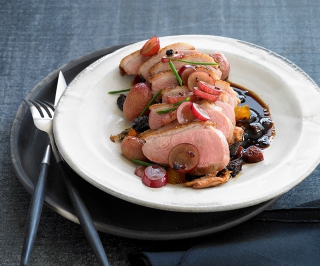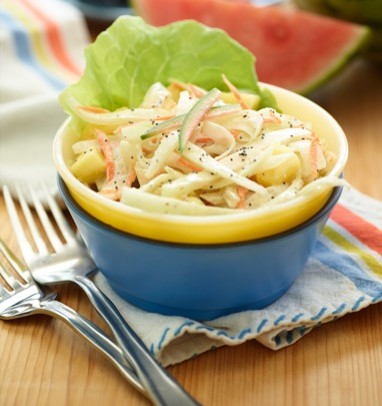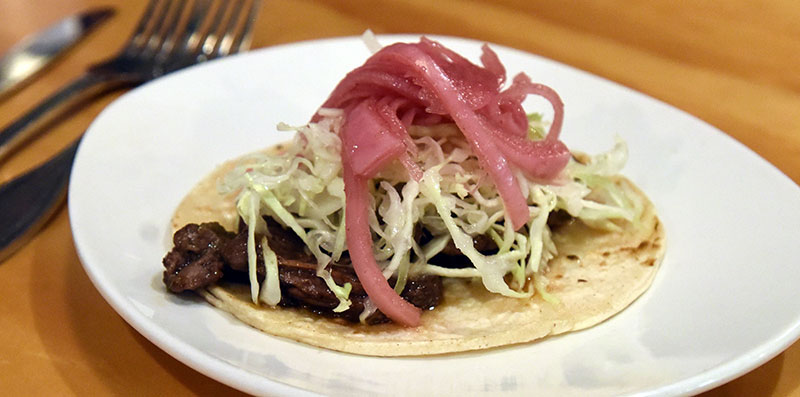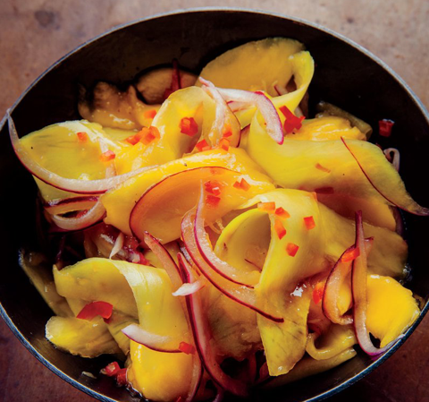
Teaching the Old Tradition of Pickling and Fermenting with Today’s Flavors
31 October 2018Pickling and fermenting resources and flavors for onions, mangos, grapes and watermelon.
By Lisa Parrish, GMC Editor
Fermented green beans garnish cocktails delivered from the front of the house during dinner service while pickled onions top egg bowls served for breakfast. The old-time process of pickling and fermenting fruits and vegetables is gaining in popularity in all culinary day parts and from the front to the back of the house.
Pickling and fermenting were developed to extend food life and are thousands of years old. But today, we have the benefits of refrigeration and an extensive transportation system that allows consumers to eat fresh food from around the world. Why is pickling and fermenting making a comeback in our modern culinary scene?
One reason, according to Stella Bernard, associate culinary instructor from Johnston and Wales University, Denver, is that millennial consumers are driving the trend. “They crave authentic food and are attached to the farming process, where in the community the food comes from and, really, to the earth. Pickling and fermenting can preserve food grown locally for use later. It is also a great way to reduce kitchen waste by using all parts of the food. Millennials love this,” she said.
Fermenting is regularly taught in culinary schools throughout brewing and beverage classes as well as bread making courses. However, culinary instructors are introducing more and more fermentation lessons, far beyond just hops and barley. Yogurt, kimchi, miso, kombucha and sauerkraut are also fermented foods consumed during all day parts that are being included in lesson plans throughout the country.
Although both pickling and fermenting change a food’s flavor profile and extend its shelf life, the processes are different.
Fermenting introduces living microcultures to food that eat the food’s sugar and starches, thereby preserving the food and changing its texture while enhancing its flavor. Pickling involves adding an acidic solution, such as vinegar or salt brine, to allow bacteria to grow and eat the food’s sugars while producing a tart-tasting lactic acid. This process also changes the texture, flavor and creates a shelf-stable product.
“You can pickle almost anything, from fruits and vegetables to meats and other proteins. Chefs have pickled everything from eggs to pigs’ feet,” she said.
Bernard also suggests pickling or fermenting left over seasonal items at the end of the term to reduce kitchen waste. “I love to make chutneys with product that’s not perfect or won’t last until the students return to the kitchens,” she said. Bernard also suggested creating a shrub - fruit-flavored fermented drinking vinegar - to use in dressings or in front of the house beverages.
Culinary instructors interested in learning more about fermenting and pickling can also download five free books. Bernard said, “These books are a great, free digital resource.” She also suggested interested instructors who would like to learn how to brew fermented kombucha tea, visit this link for a free brew log and step-by-step lesson plan on the technique.
Flavors and applications abound for pickled and fermented watermelon, onions, grapes and mangos.
Pickled Watermelon Rind and Flesh

Megan McKenna, director of foodservice and marketing for the National Watermelon Promotion Board, has observed the uptick in interest regarding fermenting and reducing kitchen waste. She said, “We’ve been working on educating chefs about making watermelon rind pickles and watermelon rind kimchi. The counter balance of sweet and sour (and sometimes spicy) in watermelon rind pickles makes it a pleasant surprise. It can be featured in relishes, presented on charcuterie plates, tucked into sandwiches, stirred into grain salads or as a finishing touch on yogurt parfaits and creamy puddings.”
She said that watermelon rind kimchi brings a salty, spicy umami flavor boost. “It elevates the flavor of scrambled eggs, grilled ham and cheese, fried rice and even on pizza.”
McKenna also noted that quick pickling watermelon flesh makes a juicy, sweet and sour garnish with a delicate crunch that could be used in applications such as country-style ribs, salads, desserts and even beverages.
Pickled Red Onions

Justin Brown chef/owner Gourmet Grub Scratch Kitchen in Greely, Colo., prefers to pickle red onions because of their color and sweetness in a quick brine that keeps the onions structurally sound and crunchy.
The chef uses pickled onions in applications such as carne asada taco and a lamb burger with mint manchego pesto, arugula and goat cheese. He noted that his pickled onions have a spicy characteristic. “We use a little allspice, bay leaf, black peppercorn, garlic and shallot as flavoring. We do a red wine vinegar coupled with a sugar cane vinegar. The sugar cane vinegar has a cloudy characteristic to it, so it has a little sweetness too. It’s not like most vinegars where it kind of punches you in the mouth — it mellows it out. You play off the sweet and salty characteristic of basically what you’re looking for in the dish. We use the salt to enhance the flavor and sweet to calm down the vinegar,” he said.
The chef also notes the growth in consumers interested in pickled foods. He suggests that is due in part to an overall interest in healthy eating. “It’s just a healthier way of eating. It is most definitely recycling old styles (of cooking). There’s not a lot of ingredients involved besides time. It takes some planning but really at the end of the day, it’s probably the oldest way of flavoring anything,” he commented.
Pickled Grapes

Pickling grapes delivers a sweet tart sensory experience that complements a wide range of ingredients, according to the California Table Grape Commission. Chefs are using them on cheese boards; omelets and quiche; antipasto platters; in appetizers; in next week salads; with center-of-the-plate proteins; cocktails and more.
Sweet grapes are immersed in a tangy pickling liquid made unique by the combination of ingredients chosen. They suggest two pickling approaches: to prepare the pickling liquid and cool it before pouring over the grapes; or to simply pour the hot liquid over the grapes and let it cool resulting in softer fruit. The commission suggests that it simply is a matter of preference and end-use of the pickled grapes. With either process, the grapes marinate in the liquid for anywhere from a couple hours to a several days. To infuse the grapes with the most flavor, an X is cut in the stem end of each grape, which allows for the liquid be absorbed directly into the fruit.
The California Table Grape Commission shared these ideas from current culinarians:
- I.d. Delafield restaurant featured a Hot-Smoked Chicken with White-Peony Tea Pickled Grapes and Coconut Rice. This pickling sauce features White Peony Tea, champagne vinegar, sugar, salt, cinnamon stick.
- Restaurant Martin menued a Duck Breast with Rosemary Pickled Grapes. This pickling sauce is comprised of aged red wine vinegar, sugar, red wine, ginger, rosemary, mustard seeds, peppercorns, cinnamon sticks, star anise.
- Citizen Public House featured an appetizer of Burrata with Pickled grapes. Its pickling sauce included apple cider vinegar, pickling spice, chili flakes, brown sugar and garlic.
- Fat Cats Restaurant previously featured pickled grapes in 1) a salad with arugula, gorgonzola, crispy prosciutto and a balsamic dressing; 2) with veal sweetbreads; 3) with grilled cheese sandwich; and 4) as a “dessert” parfait layering cantaloupe, pickled grapes, spiced pecans, and whipped cream. Their pickling sauces included one with white vinegar, Chablis, sugar, coriander seeds and cloves.
Fermented and Pickled Mango
 Angela Serna, National Mango Board marketing manager, suggests there are many mango fermented and pickled recipes in part because chefs can use this tropical fruit across its ripeness spectrum from crisp and tart green to juicy and sweet fully-ripe mango.
Angela Serna, National Mango Board marketing manager, suggests there are many mango fermented and pickled recipes in part because chefs can use this tropical fruit across its ripeness spectrum from crisp and tart green to juicy and sweet fully-ripe mango.
When preserving fresh mango, chefs should look for mature green mangos with a hint of yellow flesh. Serna said, “Think of pickled or fermented mango as a canvas for different flavors from different cultures.” Pickled and fermented mangos make versatile condiments such as mango ambra, a bright and spicy condiment popular across the Middle East. “Diced for a relish or blended into a sauce, the tangy flavor of mango amba can be spread onto brioche dough and rolled to make bruffins, swirled into hummus, used as a topping for grain bowls, stirred into yogurt for a dip, or used topping for just about any grilled protein,” said Serna.
She also suggested using pickled green mango as relish to brighten the flavor of burgers and when diced fine creating a house-made tartar sauce.
Please click here to read Chef Adam Weiner's article about how to teaching pickling to students.
